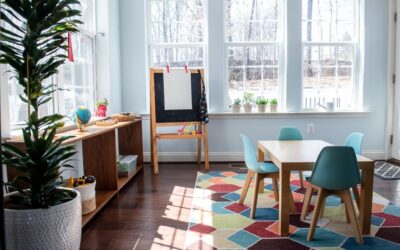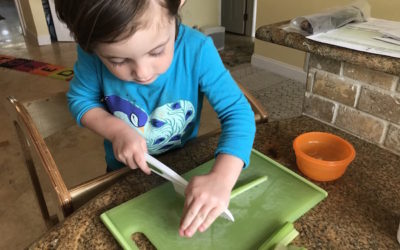Greetings from Florida! For those of you who don’t know me, I was a Lower Elementary guide and then the Director of Admissions at Greenspring before moving to Florida. I began this series on Montessori in the Home to help parents find creative ways to implement Montessori practices at home. My daughter, Lila, just turned four. Her play space has evolved since she was an infant, but the guiding principles remain the same.
Setting up a Montessori-inspired play space at home does not require a great deal of time or expense. The goal is simply to create a space that encourages independence and concentration. Here are some key components to keep in mind:
Simplify: Montessori spaces use more neutral colors and have very little (or nothing) hanging on the walls. What is displayed on the walls is carefully chosen and hanging at the child’s eye level. The goal is to reduce the visual stimulation of the environment, so that the child will be attracted to the materials (toys) and be able to concentrate on her work (play).


A sample play space for a young toddler A sample play space for a six year old
Reduce: Consider reducing the number of toys available. You may use a small shelving unit with two or three shelves and just a few items on each shelf. Putting out just a few toys at once, and rotating them regularly, allows your child to focus on what’s available. Also, rotating toys will rekindle your child’s interest in older toys that they haven’t seen for a while. When a toy has remained on the shelf for a whole week untouched, you know it’s time to put it away and put out something different.
Organize: Children have a sensitive period for order from birth through age five, peaking in early toddlerhood. You can see this through young children’s love for routine and repetition. Young children are most comfortable when their physical environments are orderly. Montessori environments support this desire for order by designating a specific spot for each material. In a play area, instead of a big toy bins full of many unrelated things, each toy has a space where it belongs on a shelf. Toys with multiple pieces, like blocks or play animals, can be organized in small baskets or trays on the shelf. You can even attach photos to each bin or shelf so that the child knows exactly where each toy belongs.
Provide varied work spaces: The furniture in Montessori classrooms is child-sized and the materials are kept on low shelves so that the child can access them independently. If you have the space at home, it’s ideal to include a child-size table and chair(s), an open space allowing for movement and large floor work, and a cozy spot for resting or recovering from an upsetting moment.
Include nature: If possible, choose a room with natural light. House plants offer children a chance to take care of something, as well as adding natural beauty to the room. Young children also love watching fish or other pets and older children can help feed and care for them as well. You might also consider setting up an outdoor play area where your child can dig in the dirt, water plants, enjoy sand and water play, and do messy art projects.
Choose toys carefully: While there is no need to fill your home with “academic” work, you can select toys that help your child develop in different ways. You might think about including toys that develop fine motor (small muscles), gross motor (big muscles), art and music, books, and open-ended items (like blocks) for creative play. It’s also important to include toys that offer a varying degree of difficulty. You want a mix of challenging toys and things that are easy and familiar for her to play with when she needs a mental break. Open-ended toys that engage rather than entertain (such as those that light up or make noises) will encourage creativity and concentration.
Give it a try! This might seem like a lot to think about, but you can pick and choose what works for your child and your home. I feel free to “break the rules.” I still keep all of Lila’s stuffed animals in one large bin. And though most gifts made of plastic or requiring batteries “disappear” after a few days, a few favorites have been allowed to stay. And despite my best intentions, getting Lila interested in “clean up time” is still a constant struggle. So don’t be too hard on yourself. Just have fun with it!
*By the way, you don’t need to spend a lot of money on toys, especially for young children. These have been some of Lila’s favorites over the years:



Scooping jingle bells into a metal muffin tin, posting poker chips into a coffee can, and posting ping pong balls through a paper towel tube.


As a toddler, Lila enjoyed the sound that polished stones made when dropped into a glass bowl; later she enjoyed sorting them by size and color; now she is interested in rocks and minerals.


Lila keeps a collection of natural treasures; recyclable materials make wonderful art supplies. Now Lila stops me on the way to the recycling bin and says, “Wait, we can make art with that!”
I have also written about setting up a Montessori kitchen, Montessori bedroom and a Montessori bathroom. Questions, comments, suggestions? Email me at mjarrell@greenspringmontessori.org.




